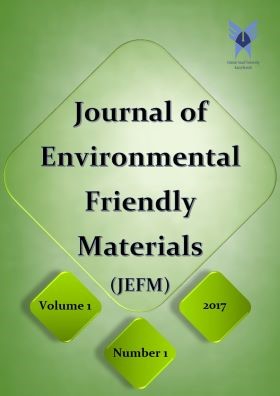Improving the Tribological Behavior of Commercially Pure Titanium Using TIG Surface Alloying
محورهای موضوعی : Journal of Environmental Friendly MaterialsA. Vahedi Nemani 1 , M. Ghaffari 2 , N. Rasekh Saleh 3 , H. Tazikeh 4
1 - Farayand Control Consulting Engineers Company, Tehran, Iran.
2 - Farayand Control Consulting Engineers Company, Tehran, Iran.
3 - Islamic Azad University, East Tehran Branch (IAUET), Engineering Faculty.
4 - Mining and Metallurgical Department, Amirkabir University of Technology, Tehran, Iran.
کلید واژه:
چکیده مقاله :
Titanium alloys are widely applied to marine, biomaterials, chemical, petrochemical and automotive industries because of their unique property such as excellent creep resistance, corrosion resistance and relative higher specific strength ratio. However, they suffer from poor tribological properties such as low surface hardness and absolute values of tensile and shear strength which result in low wear resistance. On the other hand when Ti alloys are worn, they produce a dark-colored dust which is not environmental friendly. This project is aimed at producing hard and wear resistant particles in a matrix of Commercially Pure Titanium (CP-Ti) substrate by TIG (Tungsten Inert Gas) surface alloying. Different mixtures of Molybdenum and Titanium Carbide powders were applied to the surface in order to improve the hardness of surface layers. The microstructure of TIG alloyed layers were analyzed by OM, SEM and E-DAX. It was found that the hardness of the treated layers was more than three times higher than that of the CP-Ti substrate. Moreover, the wear resistance of this coatings were between 60 to150 times better than the base material.
[1] L. Jian, H. Wang, Surf. Coat, Technol., 2(2005), 305.
[2] P. Zhang, Z. Xu, G. Zhang and Z. He, Surf. Coat. Technol., 9(2007), 4884.
[3] X. Chen, G. Wu, R. Wang, W. Guo, J. Yang, S. Cao, Y. Wang and W. Han, Surf. Coat Technol., 9(2007), 4843.
[4] X.-Y. Li, P.-Q. Wu, B. Tang and J.-P. Celis, Vacuum, 1(2005), 52.
[5] X. Chen, G. Wu, R. Wang, W. Guo, J. Yang, S. Cao, Y. Wang and W. Han, Surf. Coat. Technol., 9(2007), 4843.
[6] A. Zhechevaa, W. Shaa, S. Malinovb and A. Longa, Surf. Coat. Technol., 7(2005), 2192.
[7] F. Gil, J. biomater. Appl., 1(2002), 31.
[8] Y. Tamura, A. Yokoyama, F. Watari, M. Uo and T. Kawasaki, Mater.Trans. JIM, 12(2002), 3043.
[9] M. Benda, J. Vlcek, and J. Musil, Vacuum, 1(1995), 43.
[10] B. Tang, Pei-Qiang Wu, Xiu-Yan Li, Ai-Lan Fan, Z. Xua and J.-P. Celisb, Surf. Coat. Technol., 2(2004), 333.
[11] Y. Itoh, A. Itoh, H. Azuma, T. Hioki, Surf. Coat. Technol., 2(1999), 172.
[12] F.A. Hajbagheri, S.K. Bozorg and A. Amadeh, J. Mater. Sci., 17(2008), 5720.
[13] S. Mridha, HS. Ong, LS. Poh and P. Cheang, J. Mater. Process. Technol., 1(2001), 516.
[14] S. Mridha, B. Ng, Surf. Eng., 3(1999), 210.
[15] M. Ghaffari, M.H. Sohi, A.A. Amadeh, A.V. Nemani, Adv. Mater. Proc. Technol., 2(2016), 123.
[16] A.V. Nemani, M.H. Sohi, A.A. Amadeh, M. Ghaffari, Adv. Mater. Proc. Technol., 2(2016), 115.
[17] A.V. Nemani, M.H. Sohi, A.A. Amadeh, M. Ghaffari, Mater. Chem. Phys., 178(2016), 98.
[18] S. Zhang, W.T. Wu, M.C. Wang and H.C. Man, Surf. Coat. Technol., 1(2001), 95.
[19] E. Yun, K. Lee, and S. Lee, Surf. Coat. Technol., 1(2004), 74.
[20] R.L. Sun, D.Z. Yang, L.X. Guo and S.L. Dong, Surf. Coat. Technol., 2(2001), 307.


